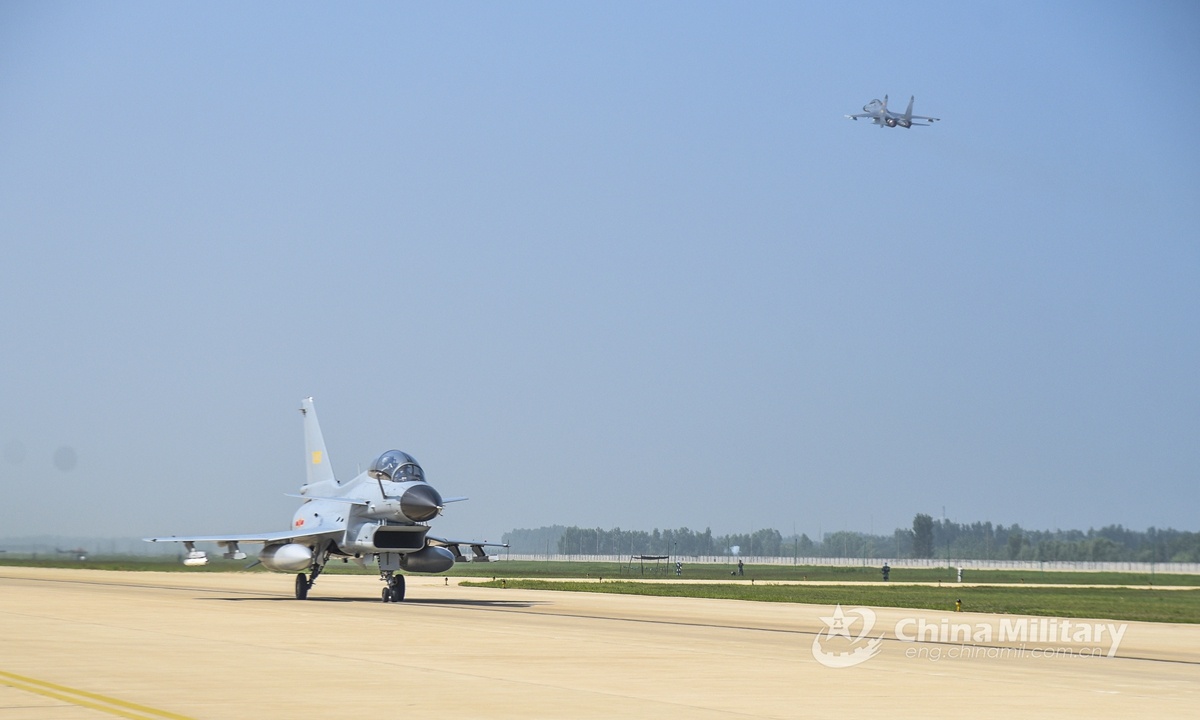
A J-10 fighter jet attached to an aviation regiment under the PLA Air Force taxis on the runway as another fighter jet takes off during a flight training exercise in late July, 2020. Photo:China Military
After the Chinese People's Liberation Army (PLA) conducted intensive aerial and naval exercises near Taiwan for two consecutive days on Wednesday and Thursday, the military on the island is fearing a potential island encirclement patrol by the PLA's two aircraft carriers, Taiwan media said on Friday.
Mainland analysts said on Friday that the PLA drills are normal training missions with the aim of honing the capabilities to win a war should one break out in the Taiwan Straits, and are responses and warnings to secessionist moves including drills that simulate a PLA attack and encouraging top US officials to visit the island.
Multiple PLA warplanes including Su-30 fighter jets and Y-8 anti-submarine aircraft again entered the island's "air defense identification zone" off the "airspace" southwest to Taiwan on Thursday, after PLA Su-30 and J-10 fighter jets conducted similar missions on Wednesday, Taiwan media reported on Thursday, citing the island's defense authority.
Taiwan's defense authority said that the Chinese mainland conducted an aerial and maritime joint exercise 90 nautical miles off the island's southwestern waters, in which a total of 21 warplanes of various types entered the island's "air defense identification zone" for 48 times. A mainland maritime research ship, which was seemingly on a reconnaissance mission, also appeared in the east side of the island, reports by Taiwan media said.
The PLA drills are likely routine exercises aimed to enhance its actual combat capabilities in the Taiwan Straits by further learning the air, sea and land areas and honing skills, Chinese mainland military expert Song Zhongping told the Global Times.
The PLA activities come at a time when the computer-aided war games phase of Taiwan's Han Kuang drills, which has the PLA in mind, are about to begin on Monday, Taiwan media reported.
Also, some Taiwan media reported that Taiwan authorities are actively promoting the visit of US Secretary of Commerce Wilbur Ross to Taiwan and may invite Keith Krach, undersecretary of State for economic growth, energy, and the environment to the island.
The recent PLA drills can serve as responses and warnings to the Taiwan secessionists and the US, showing that the PLA is capable and is becoming even more capable of reunifying the island by force if they go too far, a mainland military expert who asked not to be identified told the Global Times.
Secessionists still cannot or do not want to recognize the huge gap in military strength between the island and the mainland, and with more live-fire and real-combat-oriented exercises, the PLA should put this reality for them to realize, the expert said.
Citing speculation by an officer at the island's naval force, a separate Taiwan media report on Friday said the Taiwan military is preparing for the possibility that the Liaoning and the Shandong, the PLA's two aircraft carriers, could conduct joint exercises and encircle the island around September 22.
Both PLA aircraft carriers were spotted carrying out training exercises in early September, with the Shandong in the Bohai Sea and the Liaoning in the Yellow Sea, as of September 3, foreign media reported at that time, citing commercial satellite images.
The PLA or the mainland's Defense Ministry has not confirmed the reported aircraft carriers' movements.
Mainland experts said that the two PLA carriers can play important roles in a potential reunification-by-force operation by attacking the island from different sides and intercepting possible US intervention.
It is only a matter of time before the carriers sail pass the island of Taiwan, and it will become very normal, because if they are to enter the South China Sea or West Pacific from the Bohai Sea or Yellow Sea where they are based now, they will need to sail through the Taiwan Straits west to the Taiwan Island or the Miyako Strait and Bashi Channel east to the island, analysts said.
The Shandong will eventually leave its shipyard in Northeast China and return to its homeport in Sanya, South China's Hainan Province, during which it will likely pass the Taiwan Straits again, observers said.


